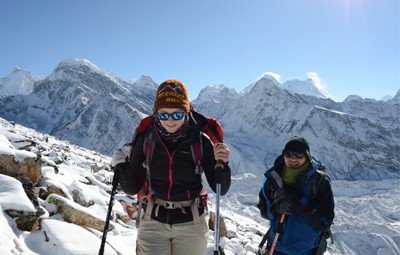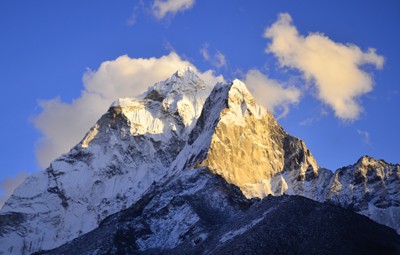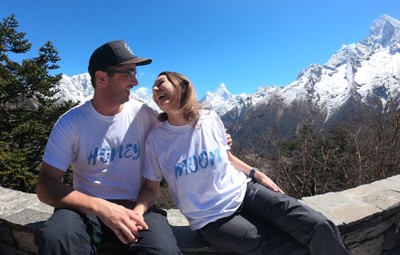About Everest Trekking Packages in 2025
Everest region trekking, or Everest trekking, is the most popular trekking destination among adventurers, as it offers one of the most stunning and remote landscapes in the world. Located in the northeastern region of Nepal, the Everest region is not only a famous destination for tourists in Nepal due to its scenic views of the world's highest peak, Mount Everest, but also for the other towering mountains that dominate the region. Known as "The Roof of the World," the region is well known for the loyalty and friendliness of its inhabitants, the Sherpa people, and for its inspiring Buddhist culture.
At 8,848 meters, Mount Everest, the highest mountain in the world, is known as Sagarmatha ("the goddess mother of the world") in Nepal. It has long been a major attraction for nature lovers and trekkers. For some, seeing Everest with their own eyes can be an emotional experience, and Rugged Trails Nepal is honored to share this experience with its guests.
Why Nepal Is an Excellent Destination for Trekking in the Everest Region (EBC Trek in 2024 AND 2025)
The Everest region is nestled within the Sagarmatha National Park, established in 1976 and covering an expansive area of 1,148 square kilometers. Throughout the trekking region, trekkers are captivated by breathtaking views of majestic peaks, serene Buddhist monasteries, and vibrant Sherpa villages. The park also boasts a rich biodiversity, with common wildlife sightings including Himalayan Tahr, Ghoral, Musk deer, Pikks (mouse hare), weasels, jackals, and occasionally Himalayan black bears, wolves, lynxes, and snow leopards. Additionally, over 118 bird species inhabit the park, with notable ones being the imperial pheasant (Danphe), blood pheasant, red-billed cough, yellow-billed cough, snow cock, snow peagon, Himalayan Griffon, and lammergeyer.
The geography of the Everest trekking area encompasses rugged rocky valleys, alpine forests, and meadows, along with charming Sherpa villages, glaciers, and icefalls. The region is arguably the most famous trekking route in the world, renowned for its breathtaking scenery. Silver fir, birch, rhododendron, and juniper trees take over the vegetation above 3,500 meters, while pine and hemlock forests dominate at lower elevations. Notable occupations in the region include barley and potato farming and yak rearing.
During the trekking season, a majority of young people in the region find employment as mountaineering and trekking guides. The tourism industry provides them with the financial means to support their families. At Rugged Trails Nepal, we are committed to providing our guides and porters with competitive salaries, comprehensive training for their specific job duties, and ensuring high-quality and safe working conditions. We consider our guides and porters to be part of our extended family, and we warmly invite you to join our family here in Nepal.
How many days does it take to reach Mount Everest Base Camp?
The 14 Days classic trek to Everest Base Camp takes 8 days in total from Lukla, with acclimatization in Namche and Dingboche. But some people reach EBC within 6 days, but it's not suggested for trekkers. If you choose to fly to Everest Base Camp by helicopter, it is just a few hours from Kathmandu.
Do I need a permit just to climb up to Everest Base Camp?
The answer is yes. You must have 2-3 different permits to enter Sagarmatha National Park. Khumbu Pasang Lhamu Rural Municipality: 2000 rupees, 3000 rupees for Sagarmatha Conservation, and maybe a TIMS card for 2000 (TIMS is not implemented now but maybe in the future).
Does Indian citizenship require a permit for the Everest base camp?
Yes, even Nepalese citizens, except for locals, require a permit for the Everest Base Camp trek. The required permits include the Sagarmatha National Park Permit and the Pasang Lhamu Rural Municipality Permit.
Is there any age limit to get a permit for EBC?
There is no upper age limit for EBC; altitude sickness should be your primary concern. You should have no trouble reaching Everest Base Camp as long as you can keep that under control. Climbers in their 70s can be seen ascending to the summit of Everest.
How hard is the trek to Everest Base Camp?
Everest Base Camp is moderately challenging. Two weeks are frequently needed for the trek. No prior trekking experience is necessary for the EBC Trek, although it is advised that trekkers be committed and in good physical shape.
Is the Everest Base Camp trek for beginners?
Everest is not a mountain that beginners should attempt to climb, but they can absolutely complete the trek to Everest Base Camp. You will climb to an altitude of 5,364 meters (17,598 feet) on this trek, which also includes multiple steep ascents and descents, rocky and icy terrain, and difficult weather conditions. A high level of fitness, endurance, and acclimation to the high altitude is required for the trek. To make the EBC journey simpler, it is advised that you swim, cycle, do yoga, and meditate.
How much does it cost to trek to Everest Base Camp?
The price of a trip to Everest Base Camp can vary based on a number of variables, including the length of the trek, airfare, the kind of lodging, the guides' levels of experience, and the services provided by the trekking company. A 12- to 14-day trip to Everest Base Camp typically costs between US$1,1550 and US$2,500 per person. This price typically covers the cost of the trekking permits, travel to and from Lukla, lodging, food, guide, and porter services, as well as insurance.
But the cost may be reduced if you decide to complete the trek on your own without using a guide or porter. Although it is advised to employ a professional guide and porter for safety and to ensure a better trekking experience, keep in mind that this is not a necessity.
What is the easiest trek to see Everest?
The easiest way to see Mount Everest from Nepal is by joining the Short Pikey Peak Trek. This trek is also known as the window trek to see Mt. Everest and other 8000-meter peaks. A day hike from Kathmandu to Nagarkot is also another way to see Mt. Everest without flying or trekking. The luxurious way to see Mt. Everest is by taking a helicopter from Kathmandu to Everest Base Camp within a few hours.
Can you see Mt. Everest from Pokhara?
The answer is no; we can't see Mount Everest from Pokhara or from Chitwan.
Do you allow overnight stays at Everest Base Camp?
There is no overnight stay at base camp as part of the Everest Base Camp Trek itinerary. Instead, we will stay in Gorak Shep and travel by foot to Base Camp for the day. Special permits are required, and there is also worry about safety when sleeping at base camp.
Is the Everest Base Camp trek crowded?
The Everest Base Camp journey will be crowded, especially in the busy spring (March–May) and fall travel seasons (September–November). Many trekkers from all over the world travel to the Everest region at these times to experience the breathtaking scenery and the thrill of ascending to the mountain's base camp.
On the trail, it's typical to run into other hikers as you make your way to Everest Base Camp, passing a number of little settlements and teahouses. During the busiest seasons of the year, the lodging and dining establishments along the route can also get quite busy, which occasionally causes a room shortage.
But, you can choose to trek during the off-seasons of winter (December to February) and monsoon if you'd like a more sedate experience (June–August).
What is the best time of year for Everest Base Camp?
Certainly, the primary trekking seasons of late September through early November and February through May are the best times to visit Everest Base Camp. Certain times of the year are ideal for trekking because the weather is typically consistent and Base Camp's temperature ranges from -6 to 12 degrees Celsius.
Since the weather is good and the skies are typically clear, October and November are regarded as the finest months to visit Everest Base Camp. During this time of year, there is a wonderful view of the mountains, and there are few chances for snowfall or rain.
In a similar spirit, because of the dry weather and temperate temperatures, the months of February, March, April, and May are also excellent for trekking to Everest Base Camp. Around this time, the rhododendron forests and wildflowers along the trail are in full bloom, making for a picturesque and vibrant hiking experience.
The Everest Base Camp can see below-freezing temperatures and erratic weather during the winter months of December through January. The trail can also be muddy and dangerous during the monsoon season, which runs from June through September. There is also a significant likelihood of rain, and visibility may be poor. It is therefore best to avoid trekking during certain times of the year.
Which trek is popular in the Everest Region?
Famous for its spectacular mountain views and challenging trekking routes, the Everest area of Nepal is home to Mount Everest. The 14-day Everest Base Camp Trek is the most well-known and sought-after trekking route out of all the several treks in the area. Nepal's rugged trails For those who want to practice yoga in the Himalayas, an 18-day hike to Everest Base Camp is more significant. The nicest parts of the Everest region include Gokyo Lake, Gokyo Ri, and the slightly challenging Cho-La Pass, as per the Everest Yoga trek itinerary. Red Bull has listed the Everest Yoga Trek as the coolest yoga spot in the world. For individuals who don't want to go up to base camp, the shortest Everest View trek is available.














